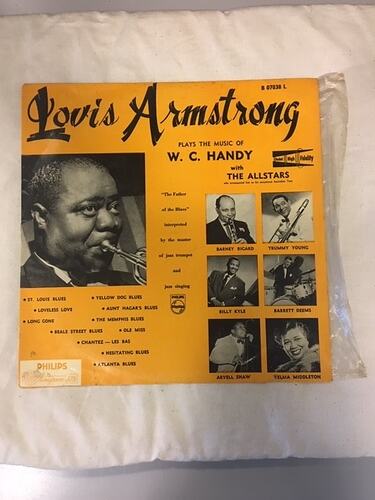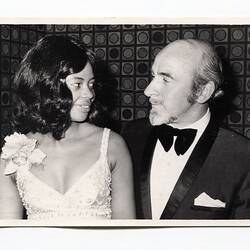Summary
An album of Louis Armstrong playing the music of W. C. Handy. It consists of a vinyl record in its original plastic sleeve within the album cover. This is the Australian version of the record, which was released in 1958. Lindsay and Sylvia Motherwell both enjoyed a variety of music, from jazz to musicals.
Sylvia Boyes (a South African-born orphan) and Lindsay Motherwell (a Melbourne-born drummer) met in Cape Town, South Africa in 1967 through their theatre connections. They fell in love but due to apartheid laws were forced to leave South Africa to marry in London. They subsequently relocated permanently to Melbourne in 1970.
Physical Description
A 12" record in its original plastic sleeve within a cardboard album cover. The front cover yellow, with the name "Louis Armstrong" across the top. The rest of the title underneath is "PLAYS THE MUSIC OF W. C. HANDY with THE ALLSTARS who accompanied him on his sensational Australian Tour." On the left is a large image of Louis, and on the right are six photos of the accompanying musicians with their names underneath them. In the centre is the by-line '"The Father of the Blues" interpreted by the master of jazz trumpet and jazz singing'. Beneath Louis' photo is a list of all the song titles on the album. The back of the cover is white paper covered in text. Across the top is a repeat of the information about the album, and the rest of the page is detailed blurbs about each song.
Significance
Statement of Historical Significance:
This collection provides a significant opportunity to represent political and personal freedom as a motivation for migrating to Australia within the international context of both apartheid in South Africa and the end of the White Australia policy in Australia. The personal narrative is well documented and the objects provide a material way to follow the lives of both Lindsay and Sylvia, both separately and where they coincide in South Africa and onwards together to Melbourne. While this is ultimately a love story, it plays out through the collection against the backdrop of apartheid South Africa, sixties London and an increasingly multicultural Australia.
More Information
-
Collecting Areas
-
User
-
User
-
Format
Gramophone Disc
-
Classification
Music & musical instruments, Playback media - analogue, Disc recordings
-
Category
-
Discipline
-
Type of item
-
Object Dimensions
305 mm (Width), 304 mm (Height)
Size of album cover
-
Keywords
South African Immigration, Travel, Musicians, Jazz Bands, Working Life, Apartheid, Racism, Immigration Policies, Music, Records

